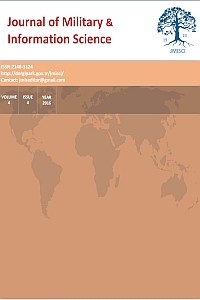Abstract
References
- AUTODYN User Manual Version 12.1, (2009), ANSYS, Inc., Cannonsburg, PA.
- Baker WE, Cox PA, Westine PS, Kulesz JJ, Strehlow RA, (1983) Explosion hazards and evaluation, Elsevier Scientific Publishing Company, New York.
- Baker WE. (1973), Explosions in air. Austin, TX: University of Texas Press.
- Bao Y, Kunnath SK. (2010) “Simplified progressive collapse simulation of RC frame-wall structures”, Engineering Structures, vol. 32, pp. 3153-3162.
- Berg AC., Weerheijm J. (2006) “Blast phenomena in urban tunnel systems”, Journal of Loss Prevention in the Process Industries, vol. 19, pp.598–603.
- Brode HL. (1955) “Numerical solution of spherical blast waves”, Journal of Applied Physics, vol. 6.
- Buonsanti M, Leonardi G. (2012) “3-D simulation of tunnel structures under blast loading” Archives of Civil and Mechanical Engineering. vol.13(1), pp.128-134.
- Department of Defense. Design of buildings to resist progressive Collapse. (2005), Unified Facilities Criteria. UFC, 4-023-03. Washington (DC).
- Dick R. (2012) Blast design and analysis, National business park-building 300, Senior Thesis.
- Dowding CH. (1996)“Construction vibrations”, Englewood Cliffs: Prentice-Hall.
- Drake JL, Little CD. (1983) “Ground shock from penetrating conventional weapons”, Proceedings of the symposium of the interaction of non-nuclear munitions with structures. Colorado, USA: US Air Force Academy.
- General Services Administration (2003). Progressive collapse analysis and design guidelines for new federal office buildings and major modernization projects. Washington (DC).
- Jiang N, Zhou C. (2012 ) “Blasting vibration safety criterion for a tunnel liner structure”, Tunneling and Underground Space Technology, vol. 32(52), pp.52-57.
- Kuhlmeyer RL, Lysmer J. (1973) “Finite element method accuracy for wave propagation Problems”. Journal of the Soil Mechanics and Foundations Division vol. 99(5).
- Lam N, Mendis P, Ngo T. (2004 )“Response spectrum solutions for blast loading”, Electronic Journal of Structural Engineering, vol. 4, pp 28-44.
- Lei Feng L, Yi X, Zhu D, Xie X, Wang Y. (2015)”Damage detection of metro tunnel structure through transmissibility function and cross correlation analysis using local excitation and measurement”, Mechanical systems and signal processing, vol. 60–61, pp. 59-74.
- Mitelman A, Elmo D. (2014) “Modelling of blast-induced damage in tunnels using a hybrid finite-discrete numerical approach”, Journal of Rock Mechanics and Geotechnical Engineering, vol.6 , pp 565-573.
- Ngo T, Mendis P, Gupta A., Ramsay J. (2007) “Blast Loading and Blast Effects on Structures” – An Overview, Electronic Journal of Structural Engineering. pp.76-91.
Assessment of Blast Induced Damage in Concrete Walls of Urban Metro Stations Using the Finite Elements Method
Abstract
Structural
engineers are faced with many different challenges when designing structures,
especially in important reinforced
concrete buildings that could be subjected to blast loads. The response of
structures due to explosions are controlled by some parameters, such as mass
and standoff distance of charge, dimensions and direction of structure,
adjacency to other buildings, and important properties of the land. A common
lateral load resisting system that is particularly vulnerable to blast loads is
the internal reinforced concrete shear wall in urban metro stations. This study
investigated the dynamic behavior of the internal wall in a metro station in
the effect of blast loading. To assess
the progressive collapse of these structures, the damaged walls should be modeled in software. The modeling of damage walls is complicated; therefore,
in this study, after analysis of the area of damage, an equal wall was proposed
to substitute for the damaged wall.
Keywords
References
- AUTODYN User Manual Version 12.1, (2009), ANSYS, Inc., Cannonsburg, PA.
- Baker WE, Cox PA, Westine PS, Kulesz JJ, Strehlow RA, (1983) Explosion hazards and evaluation, Elsevier Scientific Publishing Company, New York.
- Baker WE. (1973), Explosions in air. Austin, TX: University of Texas Press.
- Bao Y, Kunnath SK. (2010) “Simplified progressive collapse simulation of RC frame-wall structures”, Engineering Structures, vol. 32, pp. 3153-3162.
- Berg AC., Weerheijm J. (2006) “Blast phenomena in urban tunnel systems”, Journal of Loss Prevention in the Process Industries, vol. 19, pp.598–603.
- Brode HL. (1955) “Numerical solution of spherical blast waves”, Journal of Applied Physics, vol. 6.
- Buonsanti M, Leonardi G. (2012) “3-D simulation of tunnel structures under blast loading” Archives of Civil and Mechanical Engineering. vol.13(1), pp.128-134.
- Department of Defense. Design of buildings to resist progressive Collapse. (2005), Unified Facilities Criteria. UFC, 4-023-03. Washington (DC).
- Dick R. (2012) Blast design and analysis, National business park-building 300, Senior Thesis.
- Dowding CH. (1996)“Construction vibrations”, Englewood Cliffs: Prentice-Hall.
- Drake JL, Little CD. (1983) “Ground shock from penetrating conventional weapons”, Proceedings of the symposium of the interaction of non-nuclear munitions with structures. Colorado, USA: US Air Force Academy.
- General Services Administration (2003). Progressive collapse analysis and design guidelines for new federal office buildings and major modernization projects. Washington (DC).
- Jiang N, Zhou C. (2012 ) “Blasting vibration safety criterion for a tunnel liner structure”, Tunneling and Underground Space Technology, vol. 32(52), pp.52-57.
- Kuhlmeyer RL, Lysmer J. (1973) “Finite element method accuracy for wave propagation Problems”. Journal of the Soil Mechanics and Foundations Division vol. 99(5).
- Lam N, Mendis P, Ngo T. (2004 )“Response spectrum solutions for blast loading”, Electronic Journal of Structural Engineering, vol. 4, pp 28-44.
- Lei Feng L, Yi X, Zhu D, Xie X, Wang Y. (2015)”Damage detection of metro tunnel structure through transmissibility function and cross correlation analysis using local excitation and measurement”, Mechanical systems and signal processing, vol. 60–61, pp. 59-74.
- Mitelman A, Elmo D. (2014) “Modelling of blast-induced damage in tunnels using a hybrid finite-discrete numerical approach”, Journal of Rock Mechanics and Geotechnical Engineering, vol.6 , pp 565-573.
- Ngo T, Mendis P, Gupta A., Ramsay J. (2007) “Blast Loading and Blast Effects on Structures” – An Overview, Electronic Journal of Structural Engineering. pp.76-91.
Details
| Subjects | Engineering |
|---|---|
| Journal Section | Articles |
| Authors | |
| Publication Date | December 27, 2016 |
| Published in Issue | Year 2016 Volume: 4 Issue: 4 |


